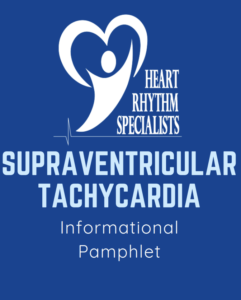What is SVT?
Supraventricular tachycardia (SVT) is an abnormally fast heartbeat (tachycardia) caused by irregular electrical activity above the top chambers of the heart. There are four main types of SVT: atrial tachycardia, atrioventricular reentrant tachycardia (AVRT), atrioventricular nodal reentry tachycardia (AVNRT), and atrial fibrillation (AFib).
How is SVT Diagnosed?
Dr. Yoo will use a combination of a physical exam, medical history, and testing, which may include:
- electrocardiogram (ECG/EKG)
- Holter monitor
- event monitor
- echocardiogram
- implantable loop recorder
- stress test
- tilt table test
- electrophysiological (EP) test
Risk Factors include:
- middle to older age
- history of heart attack, heart failure, or heart disorders
- history of heart surgery
- thyroid problems
- certain drugs and supplements
- anxiety or emotional stress
- physical fatigue
- diabetes
- obstructive sleep apnea
- pregnancy
- chronic lung disease
Causes of SVT include:
- conditions such as pregnancy, heart failure, thyroid disease,
heart disease, chronic lung disease, and Wolff-Parkinson White syndrome. - certain medications
- smoking, drinking
- caffeine
- drugs and stimulants
- surgery
Symptoms of SVT
Symptoms of SVT may last anywhere from a few minutes to a few days. Some people have no symptoms. Signs and symptoms of SVT include:
- fluttering in the chest
- rapid heartbeat (palpitations)
- shortness of breath
- lightheadedness or dizziness
- sweating
- pounding sensation in the neck
- fainting (syncope) or near-fainting
Treatments for SVT
Dr. Yoo will determine the type of treatment necessary based on the frequency of your episodes and the symptoms they cause. Treatments may include: cardioversion, antiarrhythmic medication(s), a catheter ablation procedure, a pacemaker implant, or Vagal maneuvers.
It is a good idea to keep a log of your heart rate, symptoms, and activity at the time of an episode in order to know what triggers to avoid.
Additional Resources
